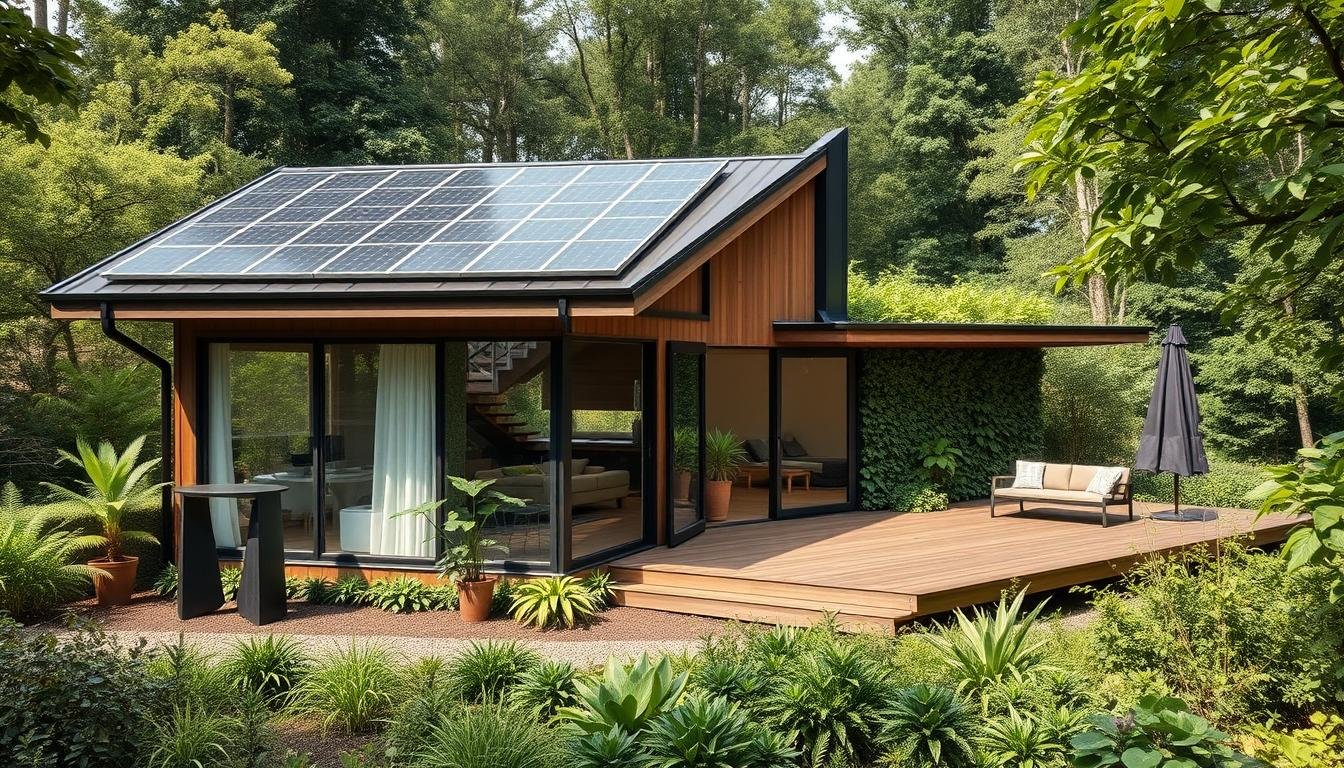Some links on this page are affiliate links. This means we may earn a commission at no additional cost to you if you click through and make a purchase. Thank you for your support!
As I sit in my cozy, environmentally-conscious home, I feel proud and responsible. Creating this sustainable sanctuary has been rewarding and eye-opening. Designing an eco-friendly home is about finding a balance between style, comfort, and caring for our planet.
In today’s world, caring for the environment is crucial. Our homes greatly affect the planet’s health. By using sustainable design, we can make homes that show our values and help the planet.
Understanding Sustainable Home Design Principles
Sustainable housing aims to build homes that are good for the environment. It focuses on using energy wisely and making homes healthy for those who live there. Key principles include using the site well, saving water, and choosing materials carefully.
What Makes a Home Sustainable
A sustainable home is built to last and to be good for the planet. It uses natural light and insulation to stay cool in summer and warm in winter. It also has systems that use renewable energy. This way, it saves resources and makes a healthy place to live.
Environmental and Economic Benefits
Sustainable homes use 20-30% less energy and water than regular homes. This means lower bills and less upkeep. They also sell for more because of their green features.
Core Elements of Green Building
- Compact, well-insulated design to minimize energy needs
- Use of local, renewable, and recycled building materials
- Efficient windows, doors, and appliances to reduce energy use
- Proper ventilation and air sealing to improve indoor air quality
- Integration of renewable energy sources, such as solar panels
- Water conservation through low-flow fixtures and smart landscaping
By following sustainable design, homes become stylish, comfy, and kind to the planet. They also save money in the long run.
“Sustainable housing is about creating a better future for our planet and our communities. It’s a holistic approach that considers the entire lifecycle of a home, from its construction to its operation and beyond.”
Planning Your Eco-Friendly Home Location and Layout
When designing an eco-friendly home, location and layout are key. They help reduce environmental impact. By thinking about these, you can make your home sustainable and beautiful.
The home’s location is important. Choose a spot close to public transport, shops, and services. This cuts down on car use. Also, pick a safe area, avoiding places at risk of floods or other disasters.
Small homes use less energy than big ones. In the Northern Hemisphere, face your home’s south side for more sunlight. This means less need for lights and heaters. Two-story homes are also more energy-smart than single-story ones.
Using passive solar design makes your home even greener. Place windows right, use materials that keep heat, and add shades. This way, you use the sun’s power to stay cozy all year and save on energy.
| Eco-Friendly Home Design Strategies | Estimated Benefits |
|---|---|
| Proximity to public transportation and amenities | Reduced carbon footprint and transportation costs |
| Compact, two-story layout | Improved energy efficiency and lower utility bills |
| Passive solar design | Year-round comfort and significant energy savings |
Plan your eco-friendly home’s location and layout well. You’ll get a place that’s good for the planet and comfy to live in. Plus, it will save you money on energy bills.
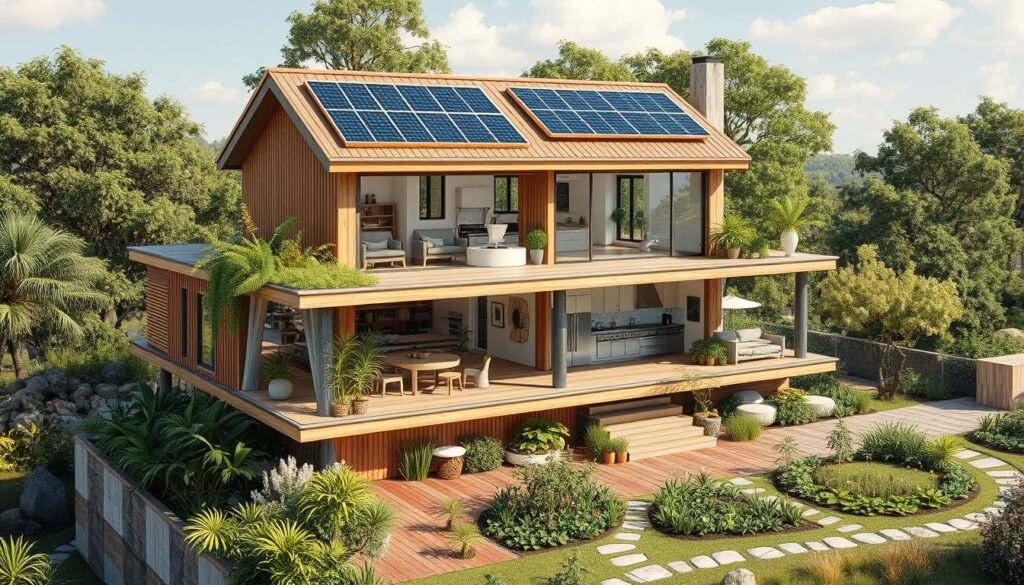
Smart Material Choices for Sustainable Construction
Building an eco-friendly home means picking the right materials. Sustainable construction uses renewable, organic, recycled, and green materials. This choice helps reduce environmental harm. It also makes homes stylish and energy-saving, helping our planet.
Recycled and Reclaimed Materials
Recycled and reclaimed materials are great for green homes. Think of recycled glass countertops, wood floors, and steel beams. They cut down waste, save resources, and lower carbon emissions.
Local and Natural Building Materials
Choosing local materials cuts down on transportation harm. Use wood, stone, and products from your area. Natural materials like bamboo, cork, and hempcrete are also good. They’re renewable, break down easily, and save energy.
Low-VOC and Non-Toxic Options
Focus on materials that don’t harm indoor air. Look for low-VOC paints, adhesives, and insulation. These options are safer for your health and the planet.
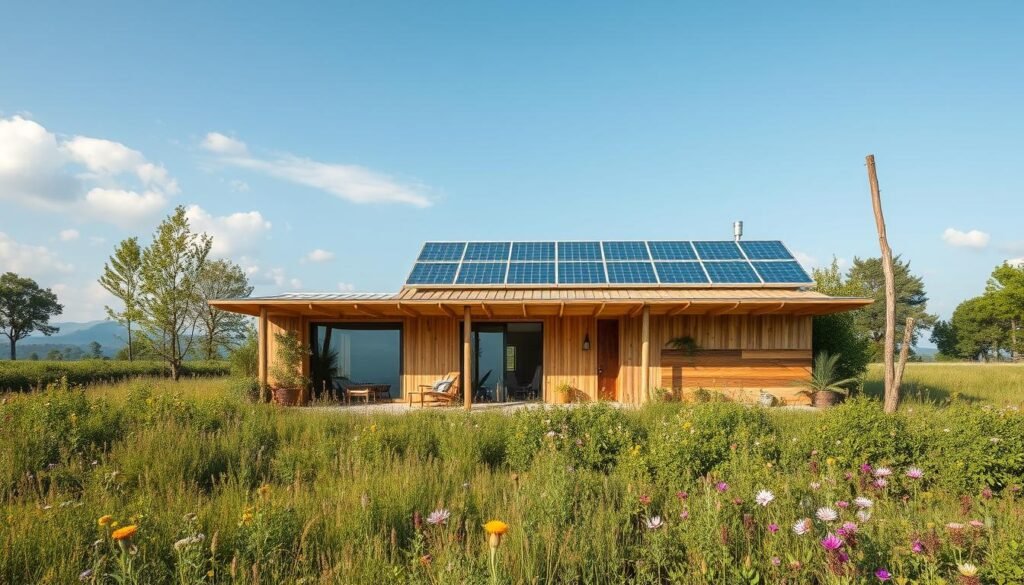
“Sustainable construction significantly reduces greenhouse gas emissions compared to conventional construction methods, aligning with efforts to combat climate change.”
Using renewable, organic, recycled, and eco-friendly materials makes homes better for the planet. It also improves the health and happiness of those living there. It’s a win-win for both our environment and our well-being.
Energy-Efficient Design Strategies
Building an energy-efficient home is key to lowering your carbon footprint and bills. A smart move is to use passive solar design. This method helps cut down on heating and cooling needs. By aligning your home with the sun, you can naturally warm and cool it.
Using insulated concrete forms (ICFs) for walls and foundations is also wise. These materials keep your home’s temperature steady all year. Don’t forget the importance of insulation and air sealing to stop energy leaks.
- Go for Energy Star certified windows, doors, and appliances for better energy use.
- Install efficient HVAC systems and smart thermostats to save on heating and cooling.
- Choose cool roofing materials to lower cooling needs.
- Use energy-efficient lighting like LEDs and timers or sensors to cut down on energy waste.
| Energy-Efficient Design Element | Benefits |
|---|---|
| Passive solar design | Reduces heating and cooling loads |
| High thermal mass materials | Regulates indoor temperature |
| Proper insulation and air sealing | Prevents energy loss |
| Energy Star certified products | Maximizes energy efficiency |
| High-efficiency HVAC systems | Optimizes heating and cooling |
| Energy-efficient lighting | Reduces unnecessary energy usage |
By using these energy-efficient design strategies, you can make a cozy, eco-friendly home. It will save you money on bills and help the planet.
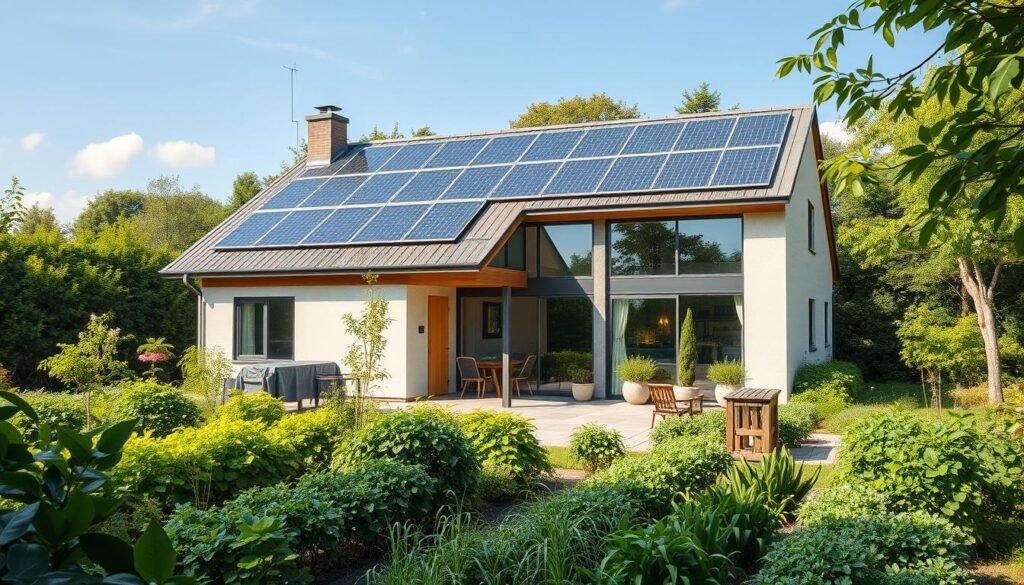
“Sustainable architecture aims to reduce energy consumption in homes through active and passive design strategies.”
Creating an Eco-Friendly Home Interior
Designing an eco-friendly home is more than just making it look good. It’s about creating a space that is both stylish and good for the planet. You can do this by choosing sustainable furniture, using natural light, and improving indoor air quality.
Sustainable Furniture and Decor
Choosing sustainable furniture is key for an eco-friendly home. Recycled steel, reclaimed wood, and bamboo are great options. They reduce the environmental impact of furniture production. Also, vintage and secondhand items can add charm and support a circular economy.
Natural Lighting Solutions
Using natural light is a big part of sustainable design. Strategic window placement and reflective surfaces can light up your space. This reduces the need for artificial lights and saves energy.
Indoor Air Quality Optimization
Good indoor air quality is crucial for health. Incorporating houseplants, using low-VOC paints, and ensuring good ventilation can improve air quality. This makes your home healthier and more sustainable.
By using these eco-friendly design tips, you can make your home stylish and sustainable. It will look great and help the planet. Your home will be both beautiful and responsible.
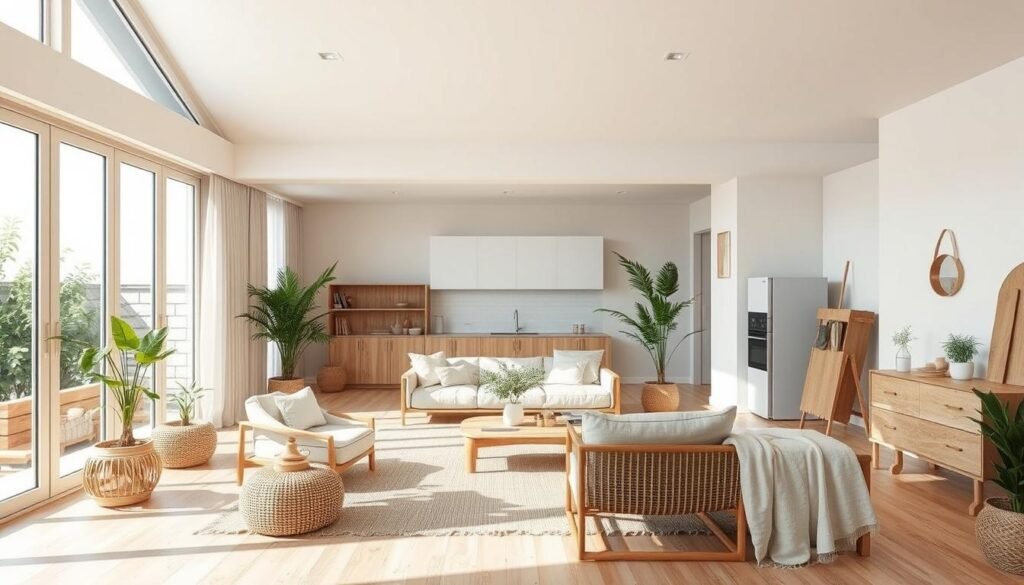
Water Conservation and Management Systems
Conserving water is key to sustainable home design. Homeowners can use many strategies to cut down water use and lessen environmental harm. Installing WaterSense-certified products like efficient toilets and showerheads is a good start. These can greatly reduce water usage.
Rainwater harvesting is another smart move. It lets homeowners collect and store rainwater for uses like watering plants or flushing toilets. This cuts down on the need for city water and helps refill groundwater.
- Use water-efficient landscaping, like mulching and choosing the right plants, to cut down on outdoor water use.
- Think about adding greywater systems to reuse household water for irrigation or other non-drinking uses. This further cuts down on fresh water use.
- Install low-flow fixtures and fix leaks quickly to avoid wasting water.
- Choose drought-resistant plants for your yard to lower the water needs of your property.
| Water Conservation Strategies | Benefits |
|---|---|
| WaterSense-certified Fixtures | Less water used without losing performance |
| Rainwater Harvesting Systems | Less need for city water, helps refill groundwater |
| Greywater Recycling Systems | Uses household wastewater for non-drinking needs |
| Low-flow Fixtures and Leak Repair | Stops water waste, saves on bills |
| Drought-resistant Landscaping | Uses less outdoor water, more drought-resistant |
By using these water conservation strategies, homeowners can greatly reduce their water use. They’ll also save money on bills and help keep their local water resources sustainable.
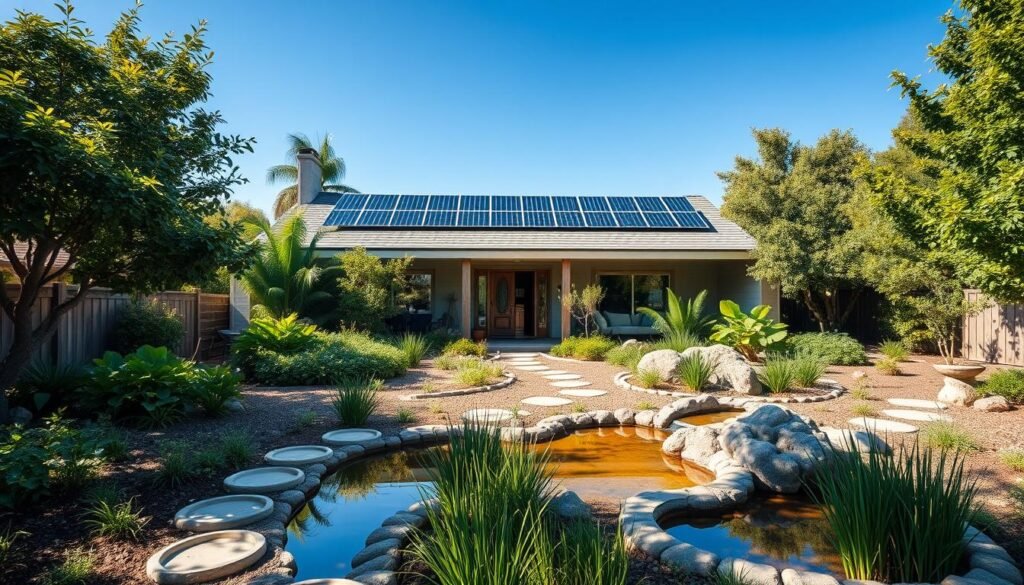
Smart Technology Integration for Sustainability
Homeowners are now focusing on making their homes eco-friendly. Smart technology plays a big role in this. It makes life easier and helps save energy and the environment.
Energy Monitoring Systems
Energy monitoring systems let homeowners see how much energy they use in real-time. They show how much electricity, gas, and water is being used. This helps people make smart choices to use less energy.
By using smart meters and devices, you can find out which appliances use the most energy. This can lead to big savings and a greener lifestyle.
Automated Climate Control
Automated climate control systems keep your home at the perfect temperature. They use sensors and algorithms to do this. For example, smart thermostats adjust the temperature based on who’s home, the weather, and what you like.
Studies show that smart thermostats can cut energy use by up to 15%.
Smart Lighting Solutions
Smart lighting is another way to make your home more sustainable. LED bulbs and connected lighting systems change color and brightness like daylight. This helps you sleep better and feel good.
These systems also let you control the lights from anywhere. So, you can turn off lights when you’re not using them. This saves even more energy.
By using smart technology, homeowners can make their homes more sustainable. They can monitor energy use, control the climate, and light levels. This helps them live in a way that’s good for the planet.
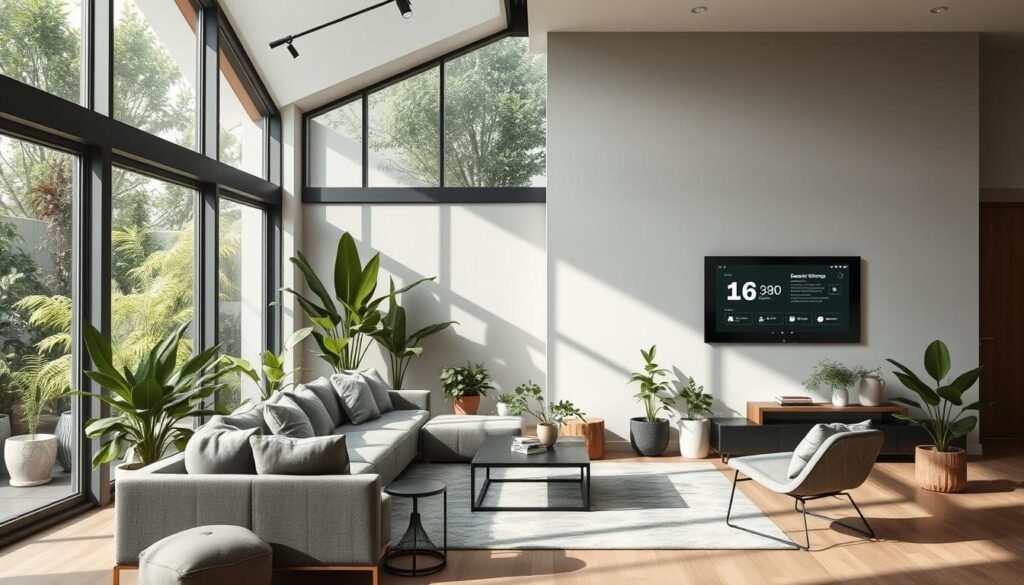
Sustainable Landscaping and Outdoor Spaces
In the quest for eco-friendly homes, sustainable landscaping and outdoor spaces are key. By using sustainable landscaping principles, we can create beautiful, easy-to-care-for, and green outdoor areas. These spaces are good for both people and the planet.
Using native plants is a big part of sustainable landscaping. These plants need less water, food, and care than other plants. They help save water, support local wildlife, and add to the beauty of our surroundings. Xeriscaping, which uses plants that need little water, can cut down water use by half or more.
Sustainable landscaping also means using permeable paving materials like TRUEGRID. These materials let water soak back into the ground, reducing runoff and helping groundwater. Adding composting systems for organic waste makes outdoor spaces even greener, reducing waste and feeding the soil.
Going green with landscaping also means creating eco-friendly outdoor living spaces. Adding solar-powered lighting and vertical gardens like green walls and roofs makes spaces more energy-efficient and fresh. It also adds more room for living and fun.
By choosing sustainable landscaping, we can lower our environmental footprint and save money. We’ll spend less on water, upkeep, and even see our property value go up. Working with experts like UGREEN can help us reach these green goals.
| Sustainable Landscaping Benefits | Potential Savings |
|---|---|
| Water Conservation | Up to 50% reduction in outdoor water use |
| Reduced Maintenance Costs | Lower yard waste, fertilizer, and labor expenses |
| Energy Efficiency | Up to 25% increase in energy efficiency |
| Increased Property Value | Attractive selling point for eco-conscious buyers |
Sustainable landscaping is a great way to make eco-friendly outdoor spaces that are good for everyone. By following these principles, we can help the planet while enjoying beautiful, cost-effective landscapes.
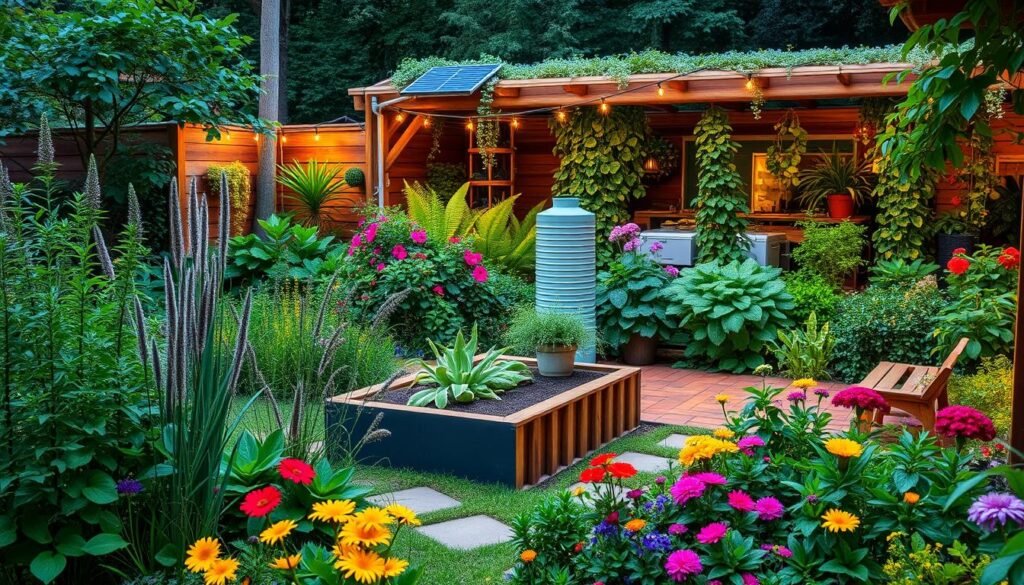
Renewable Energy Integration
When building an eco-friendly home, adding renewable energy sources is key. Renewable energy sources like solar power and wind energy are clean and efficient. They help power your home and lessen your environmental footprint.
Solar photovoltaic (PV) panels are a top choice for renewable energy. You can put them on your roof or in your yard. They make clean electricity for your home. Studies show a small solar system can be a reliable, pollution-free power source.
For those in the right spot, a small wind turbine is a cost-effective option. It’s a reliable power source. Or, you might look into geothermal heating and cooling systems. They use the Earth’s heat to efficiently warm and cool your home.
Think about adding solar water heaters too. They can meet half your hot water needs. This cuts down on energy needed for traditional water heating.
Look into tax incentives or rebates to lower the cost of these systems. Also, consider battery storage systems. They help use more of the renewable energy you make.
| Renewable Energy Option | Average Cost | Estimated Energy Production |
|---|---|---|
| Solar PV System | $3 per watt installed | 20-35 kilowatt-hours per day |
| Small Wind Turbine | $10,000 to $70,000 | Depends on local factors |
| Solar Water Heater | $5,000 to $7,000 | Up to 50% of hot water needs |
By using these renewable energy sources, you can cut down on traditional energy use. This lowers your bills and helps the planet.
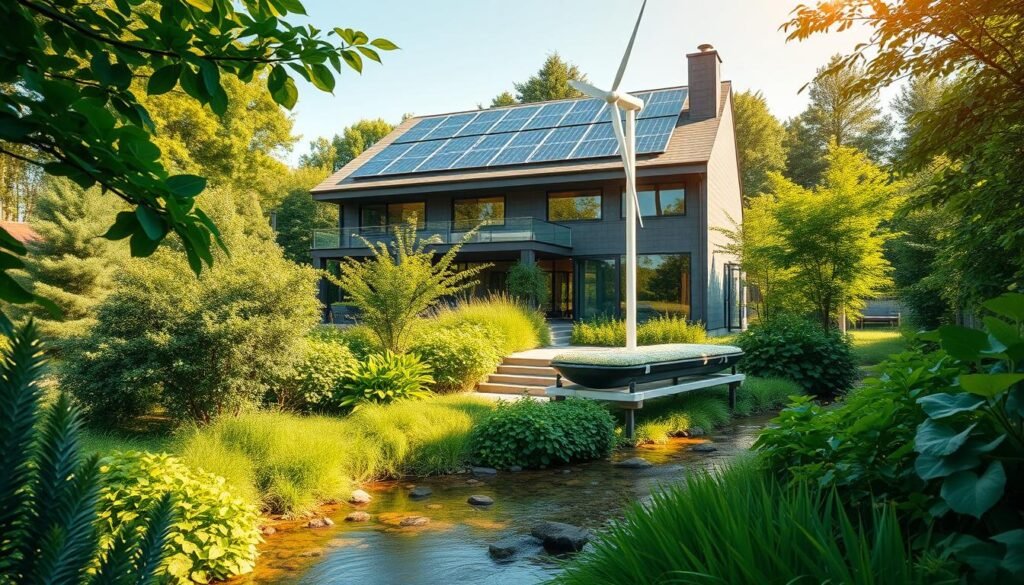
Conclusion
Creating a stylish, eco-friendly home is a big task. It needs careful planning and thinking about many sustainable ideas. Every choice, from picking the right site to using energy-saving systems, affects the home’s impact on the environment.
By choosing green building, homes can be both cozy and good-looking. They use less resources, support eco-friendly living, and help our planet. Using recycled materials, saving energy, and conserving water are key steps to a green home.
Designing an eco-friendly home is more than just cutting down on carbon emissions. It’s about living a sustainable lifestyle. By using new tech, keeping cultural values, and caring for nature, homes become sanctuaries. They inspire us and show the way for future generations.
ALSO READ: How to Use Open Shelving in Industrial Interiors
Frequently Asked Questions
What are the key principles of sustainable home design?
Sustainable home design focuses on several key areas. It aims to use the site’s natural potential and reduce energy use. It also improves water efficiency and uses materials responsibly. The goal is to protect natural resources and create healthy homes.
What are the environmental and economic benefits of sustainable homes?
Sustainable homes use 20-30% less energy and water. They also have lower maintenance costs and can increase in value. Plus, they offer better air quality and help save natural resources.
What are the core elements of green building?
Green building focuses on several key areas. It uses passive solar design and proper insulation. It also includes efficient HVAC systems and renewable energy sources. These elements make homes energy-efficient and eco-friendly.
Why is the location and layout of an eco-friendly home important?
The location and layout of an eco-friendly home are key. Homes should be near public transport and have compact designs. Proper orientation and two-story layouts also boost energy efficiency.
What are some sustainable material choices for construction?
Sustainable materials include locally sourced and recycled items. Options like glass countertops and reclaimed wood are good choices. Low-VOC paints and adhesives also improve air quality.
How can energy-efficient design strategies be implemented?
Energy-efficient design involves several strategies. It includes passive solar design and high-efficiency HVAC systems. Energy Star certified products and cool roofing materials are also important. LEDs are great for lighting.
What are some ways to create an eco-friendly home interior?
Creating an eco-friendly interior involves several steps. Choose sustainable furniture and use low-VOC paints. Maximize natural light and use recycled products. Adding houseplants and ensuring good ventilation also helps.
How can water conservation be achieved in a sustainable home?
Water conservation starts with using WaterSense products and rainwater harvesting. Water-efficient landscaping and greywater systems are also key. Fixing leaks and using drought-resistant plants are important too.
What smart home technologies can be integrated for sustainability?
Smart home technologies include energy monitoring and automated climate control. Smart lighting adjusts based on occupancy and natural light. These technologies help save energy.
How can sustainable landscaping and outdoor spaces be designed?
Sustainable landscaping uses native plants and permeable paving. It includes composting and solar-powered lighting. Blending outdoor spaces with nature is also crucial.
What renewable energy options can be integrated into an eco-friendly home?
Renewable energy options include solar panels, wind turbines, and geothermal systems. Solar water heaters are also great. Homeowners should look into tax incentives and rebates for these installations.

